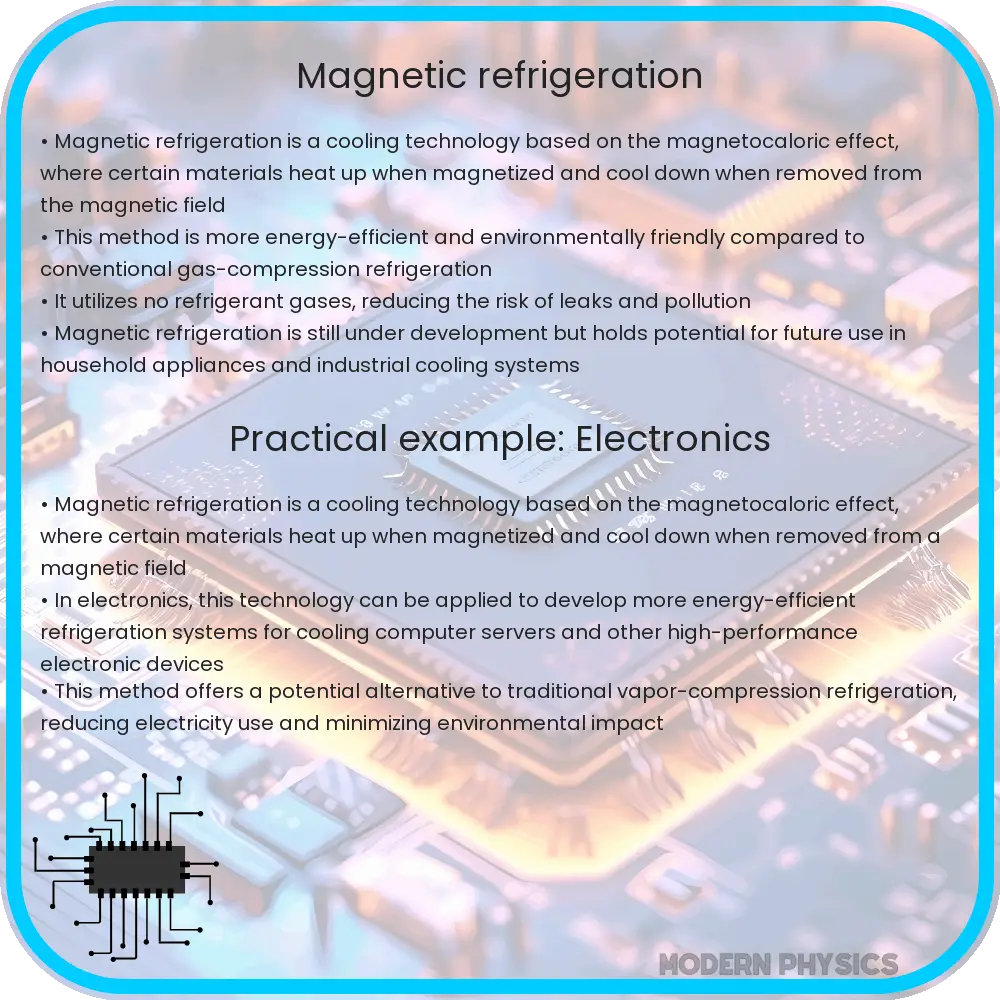Explore magnetic refrigeration, an eco-friendly, energy-efficient cooling technology using the magnetocaloric effect, poised to revolutionize cooling.

Magnetic Refrigeration: A Leap Towards Sustainable Cooling Technology
Magnetic refrigeration, an innovative and eco-friendly cooling method, is emerging as a transformative solution in the realm of refrigeration technology. This advanced system utilizes the magnetocaloric effect (MCE), a phenomenon where certain materials exhibit temperature changes when exposed to a varying magnetic field. This approach not only promises enhanced efficiency but also a significant reduction in environmental impact compared to traditional gas-compression refrigerators.
Understanding the Magnetocaloric Effect
The heart of magnetic refrigeration lies in the magnetocaloric effect. Materials exhibiting MCE, known as magnetocaloric materials (MCMs), heat up when magnetized and cool down when removed from the magnetic field. This effect is quantified by the change in entropy and temperature of the material. Gadolinium, with a chemical symbol Gd, is a commonly used MCM due to its strong MCE near room temperature. The phenomenon can be represented as Gd3+ in terms of its ions.
How Magnetic Refrigeration Works
The process of magnetic refrigeration involves a cycle of magnetization and demagnetization of MCMs. Initially, the MCM is magnetized by an external magnetic field, causing it to heat up. This heat is then removed by a fluid, usually water or helium. Subsequently, when the magnetic field is withdrawn, the MCM cools below its initial temperature. The cycle is repeated, with the cooling effect being harnessed to reduce the temperature inside the refrigerator.
Environmental and Efficiency Advantages
One of the most compelling advantages of magnetic refrigeration is its environmental friendliness. Unlike traditional refrigeration systems, it does not rely on harmful refrigerants like chlorofluorocarbons (CFCs) or hydrofluorocarbons (HFCs), which are notorious for their ozone-depleting and greenhouse gas effects. Furthermore, magnetic refrigeration systems are expected to be significantly more energy-efficient, reducing electricity consumption and associated carbon emissions.
Applications and Future Outlook
While still in the developmental stage, magnetic refrigeration holds promise for a wide range of applications, from domestic refrigerators to large-scale cooling systems in industries and data centers. The technology’s scalability and adaptability to different temperature ranges make it a potential game-changer in the cooling industry. As research progresses, we anticipate further enhancements in MCMs and system design, paving the way for a more sustainable and efficient cooling future.
Challenges and Innovations in Magnetic Refrigeration
Despite its potential, magnetic refrigeration faces several challenges that must be addressed. One of the primary obstacles is the cost and availability of magnetocaloric materials like gadolinium. The high cost of rare earth elements and the need for large quantities in refrigeration systems make it imperative to find more cost-effective and abundant alternatives. Researchers are exploring other materials with similar properties, such as lanthanum-iron-silicon compounds, to overcome this challenge. Additionally, the efficiency of the magnetic field generation and its impact on overall system performance is a key area of ongoing research.
Integration and Commercialization Prospects
Integrating magnetic refrigeration technology into existing infrastructure poses another challenge. The size, shape, and design of magnetic refrigeration systems need to be compatible with current domestic and commercial spaces. Innovations in compact and flexible design are crucial for the technology’s adoption. Commercialization also depends on demonstrating the long-term reliability and maintenance advantages of these systems over traditional refrigeration methods.
Global Impact and Sustainability
The global impact of magnetic refrigeration could be profound. By reducing reliance on harmful refrigerants and cutting down energy consumption, this technology aligns with global sustainability goals. In regions with high ambient temperatures, the efficiency and eco-friendliness of magnetic refrigeration could significantly reduce the carbon footprint associated with cooling. Moreover, as energy grids become greener, the environmental benefits of magnetic refrigeration will only increase.
Conclusion
Magnetic refrigeration stands at the forefront of a cooling revolution. With its potential for high efficiency, eco-friendliness, and adaptability, it offers a promising alternative to traditional refrigeration technologies. While challenges in material costs, system design, and integration remain, ongoing research and innovation are steadily paving the way for its broader application. As the world increasingly focuses on sustainable solutions, magnetic refrigeration represents a significant step forward in our quest for environmentally responsible and energy-efficient technologies. Embracing this cutting-edge approach could lead us into a cooler, greener future.
